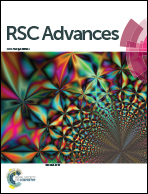Ozonation enhancement of low cost double-stranded DNA binding dye based fluorescence measurement of total bacterial load in water†
Abstract
We demonstrated the feasibility of using ozonation to enhance the performance of dsDNA binding dye SYBR Green I in the fluorescence measurement of total bacterial load in water. Unlike its membrane permeable but expensive equivalent such as SYTO82 dye, SYBR Green I is many times cheaper but membrane impermeable. Ozonation allowed SYBR Green I dye to permeate the membrane and bind with the dsDNA within by first breaching it. Using E. coli K12 bacteria at serial dilution ratios from 1/1 (980 CFU mL−1) to 1/200, we achieved corresponding quantification from 618.7 ± 9.4 to 68.0 ± 1.9 RFU (100 to 11.00% normalized RFU). In comparison, plate counting and optical density measurement were only able to quantify up till a serial dilution ratio of 1/50 (40 CFU mL−1 and 0.0421, respectively). Most importantly with ozonation, the sensitivity of SYBR Green I dye based fluorescence measurement was improved by ∼140 to 210% as compared to that without ozonation. Given its low electrical power consumption, lab-on-chip compatibility and reagent-less nature, ozonation is highly compatible with portable fluorimeters to realize low-cost monitoring of total bacterial load in water.



 Please wait while we load your content...
Please wait while we load your content...